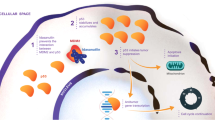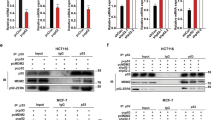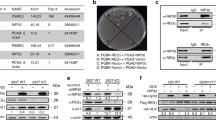Abstract
Zinc has a crucial role in the biology of p53 in that p53 binds to DNA through a structurally complex domain stabilized by zinc atom. The p53 negative regulator MDM2 protein also carries a C-terminal RING domain that coordinates two zinc atoms, which are responsible for p53 nuclear export and proteasomal degradation. In this clinically translatable study, we explored the critical role of zinc on p53 reactivation by MDM2 inhibitor, MI-219, in colon and breast cancer cells. ZnCl2 enhanced MI-219 activity (3-(4,5-Dimethylthiazol-2-yl)-2,5-diphenyltetrazolium bromide (MTT), apoptosis and colony formation), and chelation of zinc not only blocked the activity of MI-219, but also suppressed reactivation of the p53 and its downstream effector molecules p21WAF1 and Bax. N,N,N′N′-tetrakis(−)[2-pyridylmethyl]-ethylenediamine (TPEN), a specific zinc chelator, but not 1,2-bis-(o-aminophenoxy)-ethane-N,N,N′,N′-tetraacetic acid (Bapta-AM), a calcium chelator, blocked MI-219-induced apoptosis. Nuclear localization is a prerequisite for proper functioning of p53 and our results confirm that TPEN, and not Bapta-AM, could abrogate p53 nuclear localization and it interfered with p53 transcriptional activation. Addition of zinc suppressed the known p53 feedback MDM2 activation, which could be restored by TPEN. Co-immunoprecipitation studies verified that MI-219-mediated MDM2-p53 disruption could be suppressed by TPEN and restored by zinc. As such, single-agent therapies that target MDM2 inhibition, without supplemental zinc, may not be optimal in certain patients owing to the less recognized mild zinc deficiency among the ‘at-risk population’ as in the elderly who are more prone to cancers. Therefore, use of supplemental zinc with MI-219 will benefit the overall efficacy of MIs and this potent combination warrants further investigation.
This is a preview of subscription content, access via your institution
Access options
Subscribe to this journal
Receive 50 print issues and online access
$259.00 per year
only $5.18 per issue
Buy this article
- Purchase on Springer Link
- Instant access to full article PDF
Prices may be subject to local taxes which are calculated during checkout







Similar content being viewed by others
References
Alshatwi AA, Han CT, Schoene NW, Lei KY . (2006). Nuclear accumulations of p53 and Mdm2 are accompanied by reductions in c-Abl and p300 in zinc-depleted human hepatoblastoma cells. Exp Biol Med (Maywood) 231: 611–618.
Azmi AS, Aboukameel A, Banerjee S, Wang Z, Mohammad M, Wu J et al. (2010). MDM2 inhibitor MI-319 in combination with cisplatin is an effective treatment for pancreatic cancer independent of p53 function. Eur J Cancer 46: 1122–1131.
Azmi AS, Wang Z, Burikhanov R, Rangnekar VM, Wang G, Chen J et al. (2008). Critical role of prostate apoptosis response-4 in determining the sensitivity of pancreatic cancer cells to small-molecule inhibitor-induced apoptosis. Mol Cancer Ther 7: 2884–2893.
Bao B, Prasad A, Beck FW, Suneja A, Sarkar F . (2006). Toxic effect of zinc on NF-kappaB, IL-2, IL-2 receptor alpha, and TNF-alpha in HUT-78 (Th(0)) cells. Toxicol Lett 166: 222–228.
Bargonetti J, Manfredi JJ, Chen X, Marshak DR, Prives C . (1993). A proteolytic fragment from the central region of p53 has marked sequence-specific DNA-binding activity when generated from wild-type but not from oncogenic mutant p53 protein. Genes Dev 7: 2565–2574.
Beck FW, Prasad AS, Butler CE, Sakr WA, Kucuk O, Sarkar FH . (2004). Differential expression of hZnT-4 in human prostate tissues. Prostate 58: 374–381.
Brown CJ, Lain S, Verma CS, Fersht AR, Lane DP . (2009). Awakening guardian angels: drugging the p53 pathway. Nat Rev Cancer 9: 862–873.
Brown KH, Rivera JA, Bhutta Z, Gibson RS, King JC, Lonnerdal B et al. (2004). International Zinc Nutrition Consultative Group (IZiNCG) technical document. Food Nutr Bull 25: S99–203.
Butler JS, Loh SN . (2003). Structure, function, and aggregation of the zinc-free form of the p53 DNA binding domain. Biochemistry 42: 2396–2403.
Butler JS, Loh SN . (2007). Zn(2+)-dependent misfolding of the p53 DNA binding domain. Biochemistry 46: 2630–2639.
Canner JA, Sobo M, Ball S, Hutzen B, DeAngelis S, Willis W et al. (2009). MI-63: a novel small-molecule inhibitor targets MDM2 and induces apoptosis in embryonal and alveolar rhabdomyosarcoma cells with wild-type p53. Br J Cancer 101: 774–781.
Chen GD, Chou CM, Hwang SP, Wang FF, Chen YC, Hung CC et al. (2006). Requirement of nuclear localization and transcriptional activity of p53 for its targeting to the yolk syncytial layer (YSL) nuclei in zebrafish embryo and its use for apoptosis assay. Biochem Biophys Res Commun 344: 272–282.
Cho Y, Gorina S, Jeffrey PD, Pavletich NP . (1994). Crystal structure of a p53 tumor suppressor-DNA complex: understanding tumorigenic mutations. Science 265: 346–355.
Christianson DW . (1991). Structural biology of zinc. Adv Protein Chem 42: 281–355.
Collins K, Jacks T, Pavletich NP . (1997). The cell cycle and cancer. Proc Natl Acad Sci USA 94: 2776–2778.
Ding K, Lu Y, Nikolovska-Coleska Z, Qiu S, Ding Y, Gao W et al. (2005). Structure-based design of potent non-peptide MDM2 inhibitors. J Am Chem Soc 127: 10130–10131.
Ding K, Lu Y, Nikolovska-Coleska Z, Wang G, Qiu S, Shangary S et al. (2006). Structure-based design of spiro-oxindoles as potent, specific small-molecule inhibitors of the MDM2-p53 interaction. J Med Chem 49: 3432–3435.
Feng Z, Hu W, Rajagopal G, Levine AJ . (2008). The tumor suppressor p53: cancer and aging. Cell Cycle 7: 842–847.
Giannakakou P, Nakano M, Nicolaou KC, O'Brate A, Yu J, Blagosklonny MV et al. (2002). Enhanced microtubule-dependent trafficking and p53 nuclear accumulation by suppression of microtubule dynamics. Proc Natl Acad Sci USA 99: 10855–10860.
Hambidge KM, Krebs NF, Miller L . (1998). Evaluation of zinc metabolism with use of stable-isotope techniques: implications for the assessment of zinc status. Am J Clin Nutr 68: 410S–413S.
Ho E . (2004). Zinc deficiency, DNA damage and cancer risk. J Nutr Biochem 15: 572–578.
Ho E, Ames BN . (2002). Low intracellular zinc induces oxidative DNA damage, disrupts p53, NFkappa B, and AP1 DNA binding, and affects DNA repair in a rat glioma cell line. Proc Natl Acad Sci USA 99: 16770–16775.
Ho E, Song Y . (2009). Zinc and prostatic cancer. Curr Opin Clin Nutr Metab Care 12: 640–645.
Itahana K, Mao H, Jin A, Itahana Y, Clegg HV, Lindstrom MS et al. (2007). Targeted inactivation of Mdm2 RING finger E3 ubiquitin ligase activity in the mouse reveals mechanistic insights into p53 regulation. Cancer Cell 12: 355–366.
Kubbutat MH, Jones SN, Vousden KH . (1997). Regulation of p53 stability by Mdm2. Nature 387: 299–303.
Lane DP, Fischer PM . (2004). Turning the key on p53. Nature 427: 789–790.
Levine AJ . (1997). p53, the cellular gatekeeper for growth and division. Cell 88: 323–331.
Levine AJ, Wu MC, Chang A, Silver A, Attiyeh EF, Lin J et al. (1995). The spectrum of mutations at the p53 locus. Evidence for tissue-specific mutagenesis, selection of mutant alleles, and a “gain of function” phenotype. Ann N Y Acad Sci 768: 111–128.
Lindstrom MS, Jin A, Deisenroth C, White WG, Zhang Y . (2007). Cancer-associated mutations in the MDM2 zinc finger domain disrupt ribosomal protein interaction and attenuate MDM2-induced p53 degradation. Mol Cell Biol 27: 1056–1068.
Marine JC, Lozano G . (2010). Mdm2-mediated ubiquitylation: p53 and beyond. Cell Death Differ 17: 93–102.
Meek DW . (1998). Multisite phosphorylation and the integration of stress signals at p53. Cell Signal 10: 159–166.
Meplan C, Richard MJ, Hainaut P . (2000). Metalloregulation of the tumor suppressor protein p53: zinc mediates the renaturation of p53 after exposure to metal chelators in vitro and in intact cells. Oncogene 19: 5227–5236.
Meplan C, Verhaegh G, Richard MJ, Hainaut P . (1999). Metal ions as regulators of the conformation and function of the tumour suppressor protein p53: implications for carcinogenesis. Proc Nutr Soc 58: 565–571.
Mohammad RM, Wu J, Azmi AS, Aboukameel A, Sosin A, Wu S et al. (2009). An MDM2 antagonist (MI-319) restores p53 functions and increases the life span of orally treated follicular lymphoma bearing animals. Mol Cancer 8: 115.
O'Brate A, Giannakakou P . (2003). The importance of p53 location: nuclear or cytoplasmic zip code? Drug Resist Updat 6: 313–322.
Pavletich NP, Chambers KA, Pabo CO . (1993). The DNA-binding domain of p53 contains the four conserved regions and the major mutation hot spots. Genes Dev 7: 2556–2564.
Prasad AS . (2001). Discovery of human zinc deficiency: impact on human health. Nutrition 17: 685–687.
Prasad AS . (2004). Zinc deficiency: its characterization and treatment. Met Ions Biol Syst 41: 103–137.
Prasad AS, Bao B, Beck FW, Sarkar FH . (2001). Zinc activates NF-kappaB in HUT-78 cells. J Lab Clin Med 138: 250–256.
Prasad AS, Bao B, Beck FW, Sarkar FH . (2002). Zinc enhances the expression of interleukin-2 and interleukin-2 receptors in HUT-78 cells by way of NF-kappaB activation. J Lab Clin Med 140: 272–289.
Prasad AS, Fitzgerald JT, Hess JW, Kaplan J, Pelen F, Dardenne M . (1993). Zinc deficiency in elderly patients. Nutrition 9: 218–224.
Shangary S, Qin D, McEachern D, Liu M, Miller RS, Qiu S et al. (2008). Temporal activation of p53 by a specific MDM2 inhibitor is selectively toxic to tumors and leads to complete tumor growth inhibition. Proc Natl Acad Sci USA 105: 3933–3938.
Shangary S, Wang S . (2009). Small-molecule inhibitors of the MDM2-p53 protein-protein interaction to reactivate p53 function: a novel approach for cancer therapy. Annu Rev Pharmacol Toxicol 49: 223–241.
Vassilev LT . (2007). MDM2 inhibitors for cancer therapy. Trends Mol Med 13: 23–31.
Verhaegh GW, Parat MO, Richard MJ, Hainaut P . (1998). Modulation of p53 protein conformation and DNA-binding activity by intracellular chelation of zinc. Mol Carcinog 21: 205–214.
Verma R, Rigatti MJ, Belinsky GS, Godman CA, Giardina C . (2010). DNA damage response to the Mdm2 inhibitor nutlin-3. Biochem Pharmacol 79: 565–574.
Wallace M, Worrall E, Pettersson S, Hupp TR, Ball KL . (2006). Dual-site regulation of MDM2 E3-ubiquitin ligase activity. Mol Cell 23: 251–263.
Wawrzynow B, Pettersson S, Zylicz A, Bramham J, Worrall E, Hupp TR et al. (2009). A function for the RING finger domain in the allosteric control of MDM2 conformation and activity. J Biol Chem 284: 11517–11530.
Yu S, Qin D, Shangary S, Chen J, Wang G, Ding K et al. (2009). Potent and orally active small-molecule inhibitors of the MDM2-p53 interaction. J Med Chem 52: 7970–7973.
Zalewski PD, Forbes IJ, Betts WH . (1993). Correlation of apoptosis with change in intracellular labile Zn(II) using zinquin [(2-methyl-8-p-toluenesulphonamido-6-quinolyloxy)acetic acid], a new specific fluorescent probe for Zn(II). Biochem J 296 (Part 2): 403–408.
Zalewski PD, Forbes IJ, Seamark RF, Borlinghaus R, Betts WH, Lincoln SF et al. (1994). Flux of intracellular labile zinc during apoptosis (gene-directed cell death) revealed by a specific chemical probe, Zinquin. Chem Biol 1: 153–161.
Acknowledgements
National Cancer Institute, NIH Grant R01CA109389 (RM Mohammad) and NIH Grant 5R01CA101870 (FH Sarkar) are acknowledged. We sincerely acknowledge the Guido foundation for their support.
Author information
Authors and Affiliations
Corresponding author
Ethics declarations
Competing interests
Dr Ramzi M Mohammad, Dr Fazlul H Sarkar and Dr Shaomeng Wang are funded from the NIH. Dr Shaomeng Wang and Dr Dajun Yang own equity in Ascenta Therapeutics and are consultants for the company and receive compensation for their services. The rest of the authors in this paper have no potential conflict of interest.
Additional information
Supplementary Information accompanies the paper on the Oncogene website
Supplementary information
Rights and permissions
About this article
Cite this article
Azmi, A., Philip, P., Beck, F. et al. MI-219-zinc combination: a new paradigm in MDM2 inhibitor-based therapy. Oncogene 30, 117–126 (2011). https://doi.org/10.1038/onc.2010.403
Received:
Revised:
Accepted:
Published:
Issue Date:
DOI: https://doi.org/10.1038/onc.2010.403
Keywords
This article is cited by
-
Zinc and zinc-containing biomolecules in childhood brain tumors
Journal of Molecular Medicine (2016)
-
Drugging the p53 pathway: understanding the route to clinical efficacy
Nature Reviews Drug Discovery (2014)
-
Comparative In Vivo Evaluations of Curcumin and Its Analog Difluorinated Curcumin Against Cisplatin-Induced Nephrotoxicity
Biological Trace Element Research (2014)
-
Systems analysis reveals a transcriptional reversal of the mesenchymal phenotype induced by SNAIL-inhibitor GN-25
BMC Systems Biology (2013)



